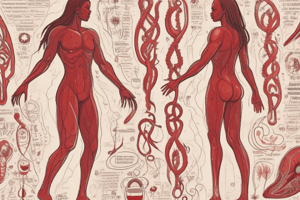Podcast
Questions and Answers
What is the primary genetic mutation responsible for Sickle Hemoglobin (Hb S)?
What is the primary genetic mutation responsible for Sickle Hemoglobin (Hb S)?
- Insertion at the third codon of the gamma gene, where cytosine is inserted.
- Substitution at the sixth codon of the beta gene, where adenine replaces guanine. (correct)
- Substitution at the first codon of the alpha gene, where thymine replaces cytosine.
- Deletion at the tenth codon of the delta gene, where guanine is deleted.
Which of the following is a consequence of the altered hemoglobin structure in individuals with Sickle Hemoglobin?
Which of the following is a consequence of the altered hemoglobin structure in individuals with Sickle Hemoglobin?
- Formation of red blood cell fibers upon deoxygenation, leading to a sickle shape. (correct)
- Enhanced flexibility of red blood cells, allowing easier passage through capillaries.
- Reduced risk of anemia due to increased hemoglobin production.
- Increased oxygen-carrying capacity of red blood cells.
Which of the following factors significantly influences the prevalence of Hb S?
Which of the following factors significantly influences the prevalence of Hb S?
- High socioeconomic status and access to healthcare.
- A diet rich in iron and folic acid.
- Living at high altitudes with low oxygen levels.
- Consanguinity, the malaria hypothesis, family size, and migration patterns. (correct)
In the study conducted at Maharajgunj Medical Campus, which ethnic group showed the highest representation of sickle hemoglobin cases?
In the study conducted at Maharajgunj Medical Campus, which ethnic group showed the highest representation of sickle hemoglobin cases?
What is the likely explanation for the high prevalence of the sickle cell trait in specific African populations?
What is the likely explanation for the high prevalence of the sickle cell trait in specific African populations?
According to the study, what range did hemoglobin levels commonly fall within for individuals diagnosed with sickle hemoglobin disorders?
According to the study, what range did hemoglobin levels commonly fall within for individuals diagnosed with sickle hemoglobin disorders?
If a patient is diagnosed with sickle cell trait (AS), what symptoms are they most likely to experience?
If a patient is diagnosed with sickle cell trait (AS), what symptoms are they most likely to experience?
What laboratory method was used in the study at Maharajgunj Medical Campus to identify different hemoglobin variants?
What laboratory method was used in the study at Maharajgunj Medical Campus to identify different hemoglobin variants?
Flashcards
Sickle Hemoglobin (Hb S)
Sickle Hemoglobin (Hb S)
A pathological hemoglobin mutation that causes red blood cells to form a sickle shape when deoxygenated.
Hb S Mutation
Hb S Mutation
The genetic substitution of valine for glutamic acid at the sixth codon of the beta-globin gene.
Sickle Cell Trait (AS)
Sickle Cell Trait (AS)
Individuals carrying one copy of the sickle cell gene, typically without severe symptoms.
Sickle Cell Anemia (SS)
Sickle Cell Anemia (SS)
Signup and view all the flashcards
Consanguinity
Consanguinity
Signup and view all the flashcards
Malaria Hypothesis
Malaria Hypothesis
Signup and view all the flashcards
Hemoglobin Electrophoresis
Hemoglobin Electrophoresis
Signup and view all the flashcards
Mean Corpuscular Volume (MCV)
Mean Corpuscular Volume (MCV)
Signup and view all the flashcards
Study Notes
- Sickle Hemoglobin is the world's most common pathological hemoglobin mutation, causing red blood cells to form a sickle shape upon deoxygenation.
- In Hb S, adenine replaces guanine at the sixth codon of the beta gene, encoding valine instead of glutamic acid.
- Red blood cells form fibers upon deoxygenation because of this substitution, causing a sickle shape.
- This sickling can cause anemia, pain crises, and organ damage.
- Sickle cell trait (AS) carriers are usually asymptomatic.
- Sickle cell anemia (SS) leads to more severe complications.
- Consanguinity, the malaria hypothesis, family size, and migration patterns affect Hb S prevalence.
- The highest sickle cell trait concentrations are in tropical African populations and parts of the Mediterranean and India.
- About 45% of some African populations have the sickle cell trait.
- A significant number of African Americans carry the sickle gene.
- Hb S offers protection against malaria.
Study at Maharajgunj Medical Campus
- Study was conducted from January 2011 to January 2013 at Maharajgunj Medical Campus.
- The goal was to assess Sickle Hemoglobin burden among patients.
- Data from various ethnic backgrounds was analyzed.
- Hemoglobin levels were reviewed.
- Testing was done for sickle cells.
- Hemoglobin electrophoresis was performed using cellulose acetate.
- There were 35 diagnosed cases in total.
- There were more males affected than females.
- Many patients were aged 11-20 years.
- Most patients' hemoglobin levels were between 6-8 gm/dl.
- A few patients had severe anemia.
Ethnic Prevalence
- The Tharu community had the most cases.
- There is likely a correlation with geographic prevalence related to malaria risk.
- All cases examined had normal mean corpuscular volumes.
- Sickle cell disease was confirmed in several cases via electrophoresis.
- The results align with existing literature, corroborating male predominance and age trends.
- Further studies should explore the genetic epidemiology of sickle hemoglobin and its implications in diverse ethnic groups in Nepal.
- Enhanced screening for sickle hemoglobin in patients, especially in malarial regions, is critical for better management of anemia cases.
Studying That Suits You
Use AI to generate personalized quizzes and flashcards to suit your learning preferences.
Description
Sickle hemoglobin (HbS) is a common mutation causing red blood cells to sickle upon deoxygenation. This is due to a substitution in the beta-globin gene, leading to complications like anemia and organ damage. Carriers of the sickle cell trait are typically asymptomatic, while those with sickle cell anemia face more severe health issues.




